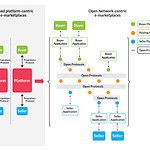India Needs a Holistic and Effective Techplomacy Strategy
— Arjun Gargeyas
Earlier this year, the Takshashila Institution published the Techno-strategic Doctrine for India. The doctrine outlined the fundamental principles India must follow to springboard as a technology superpower. As the doctrine mentions, one of the critical approaches for India to reach the status of a technology superpower is by becoming a vital node in the global technology ecosystem and building strong links with states that share its interests and values and with which it enjoys economic complementarities.
Takshashila’s newly released discussion document titled India’s Approach to Technology Diplomacy by Arjun Gargeyas provides a clear and well-defined pathway for India to become a global technology player. A summary of the arguments is the highlight of this edition ofTechnopolitik.
India Needs a Holistic and Effective ‘Techplomacy’ Strategy
Technological advancements in the 21st Century have heightened the role of technology in the diplomacy arena. Technically adept nation-states are developing their own strategies to integrate technology with their foreign policy and diplomatic initiatives. But how can technology be used as a credible diplomatic plank by the Indian State to further its national and geopolitical interests?
The government of India, driven by the nation’s technological growth, has gradually embraced the concept of integrating technology into achieving national and geopolitical goals. Official government documents, departmental strategies and policy changes have increasingly focused on how science and technology can shape diplomatic efforts in the near future.
The Science, Technology and Innovation Policy (STIP) 2013 was one of the instances that an intersection of technology and diplomacy found a mention in an official government document. The document states that the 'policy framework will enable strategic partnerships and alliances with other nations through both bilateral and multilateral cooperation in science, technology and innovation. Science diplomacy, technology synergy and technology acquisition models will be judiciously deployed based on strategic relationships.
This was further cemented in the most recently released draft STIP-2020 document. It discusses the role of science and technology (S&T) in reorganising India’s foreign policy priorities and shaping the global technology ecosystem.
There has also been considerable movement on the political front regarding the role of technology in diplomacy itself. In 2015, Prime Minister Narendra Modi asserted that science and technology would be put at the forefront of India’s diplomatic engagement in the future. In 2020, the Ministry of External Affairs (MEA) created technically specialised divisions, such as the Cyber Diplomacy Division, E-Governance and Information Technology Division, and the New Emerging and Strategic Technologies Division.
Apart from India’s policy directives, the government has ensured that technology has been incorporated into different diplomatic agreements, especially with established technological powers. These agreements are in the interest of utilising outside support to build India’s technical competency and technology-based alliances.
While these decisions have showcased movement on the techplomacy front, the Indian state needs a more comprehensive and well-rounded approach to using technology in the diplomatic space. This can be achieved through a three-fold strategy focusing on the pathway for any current and future administration to employ technology as a strategic diplomatic tool. The three principles are explained below.
Principle 1: Focus on Areas of Strengths in India’s Technology Stack
The Indian state should focus on critical areas of strength in its technology ecosystem, which can serve as potential tools of diplomatic leverage. The primary task of employing technology as a soft power tool is to pinpoint certain tech-driven areas in which the country has built expertise. Once identified, these areas can be concentrated and developed further. Investment by the state (both financial and human resources) in these critical areas that India has developed a comparative advantage in can cement the country’s leadership credentials in that particular domain. These areas of strength, when identified and developed, can translate into Indian influence in the global tech landscape.
A framework India can use for this is to analyse the export capabilities and domestic IP innovation levels in certain areas of technologies. If India can export specific technology products on a large scale, it can positively impact the diplomatic aspect of the country as well. The biotech space, including vaccines and drugs, is an area that India can focus on. The other criterion is the ability of the Indian domestic tech industry to own IP and have a high level of innovation in a specific area of technology. The fintech ecosystem, including the digital payments arena, is where India has created a name for itself and has managed to penetrate external markets with international acceptance (UPI and RuPay are now accepted in over five different countries).
A framework for assessing India’s technological strengths
Principle 2: Foster Multilateralism as a Necessity for Tech Development
The concept of self-sufficiency in emerging technologies must be re-examined with the Indian state championing and fostering multilateral efforts in its tech diplomacy outreach. It should be noted that there are no national industries but the existence of global supply chains. So the role of diplomacy will be central, not secondary.
In the technology sphere, diplomacy is not about seeking entry into an exclusive alliance or club but about maximising a state’s integration with the existing global value chains. Multilateralism in different critical and emerging technology fields should be more of an entrepreneurial decision to improve access and combine scientific or technical knowledge. In that regard, promoting the growth of open source technologies (and built on open standards) with very little or no entry barriers in the form of licences and royalty fees must be prioritised on the multilateral front. This can engage more stakeholders, improve accessibility, and increase multilateral efforts toward technology dissemination.
But even with the case of open technologies, India must walk the talk. During the development of Covid-19 vaccines, there was a call by the developing countries to remove the intellectual property and licensing restrictions on Covid-19 vaccine research for public health reasons. However, even after the conversation on open vaccines at the World Trade Organisation (WTO), the Indian government did not open up the tech behind India’s indigenous vaccine, Covaxin. Hence, if India wants to lead and engage in multilateral efforts, opening up its domestic technology IP to the world should be a priority.
Principle 2: Foster Multilateralism as a Necessity for Tech Development
This expansion of the technology-oriented Sinosphere has made other states take cognisance and increase diplomatic outreach to counter China’s ever-increasing growth. However, India, as a responsible technological power, can learn from China’s tech-driven influence in two ways.
Export Tech Infrastructure through Foreign Policy Projects: The Chinese government has exported digital infrastructure (hardware, software, networks and systems) with the help of their domestic private sector giants to many BRI partner countries. India can rely on its own foreign policy projects and initiatives to build digital infrastructure beyond its borders. This will ensure two things: One, it will build and support a robust domestic technology industry capable of competing on a global scale. Two, these digital infrastructure projects using Indian technologies (equipment, software etc.) will serve as strategic assets for the state and help increase the footprint of the Indian technological ecosystem.
Focus on Key Battlegrounds of Digital Competition: The Chinese state actively pushes for their consumer tech to be adopted in regions such as Africa, Central Asia and South East Asia. The state has actively used its foreign policy projects, such as the Belt and Road Initiative (BRI), to get more partners on board and convince them to use technologies developed by China and its technology companies. The Indian state’s main focus should be diplomatic outreach through its domestic private sector firms to help set up infrastructure in regions still developing technologically. For example, Indian telecommunication firms such as Airtel and Jio can be used to set up 5G networks in regions like Africa and Latin America, which rely on foreign import of technology.
Taking Tech-Diplomacy Forward
Tech-diplomacy can only succeed when there is a push within the government, specifically the Ministry of External Affairs. A primary objective would be a foreign service officer within the government who can serve as the state’s official ‘tech diplomat’. The position of Tech Ambassador within Denmark’s Ministry of Foreign Affairs and the UK Consul General who serves as a Technology Envoy are specifically given the responsibilities of technology outreach. France's position of Digital Ambassador handles all international technology cooperation and diplomatic engagements as a state representative. The government of Australia appointed its first-ever Ambassador for Cyber Affairs and Critical Technology in 2021.
These are some templates the Indian state can follow and curate a position specifically within the Indian Foreign Service (IFS) to handle technology negotiations for advancing India's national goals and interests. The role of existing Science and Tech (S&T) Counsellors under the Science Wings programme at embassies in Berlin, Tokyo, Moscow and Washington DC can be expanded to include technology outreach focusing on strategic cooperation, military applications and governance frameworks related to emerging and strategic technologies. The number of these counsellors should be increased and provided adequate technical knowledge or expertise to understand certain technologies’ geopolitical and geoeconomic aspects. This can help increase engagement and ensure India drives forward conversations on technology-related foreign policies.
Finally, now that the MEA has specific divisions that have been created (such as NEST and the Cyber Diplomacy Division) under the ministry, a nodal agency can be established by the Indian state which can coordinate between the different MEA divisions, S&T counsellors and other foreign service officers specifically handling technology outreach at the multilateral level. The nodal agency can also rope in the help of the private sector’s international footprint to put forth the country’s case at global technology forums. The agency can eventually take on the role of coordinating India’s tech diplomacy initiatives.
India, in the long run, will benefit from being integrated into the global technology ecosystem and engaging with other like-minded nation-states through diplomacy. This would achieve its key objectives of economic integration and governance participation in the technology realm.












Share this post